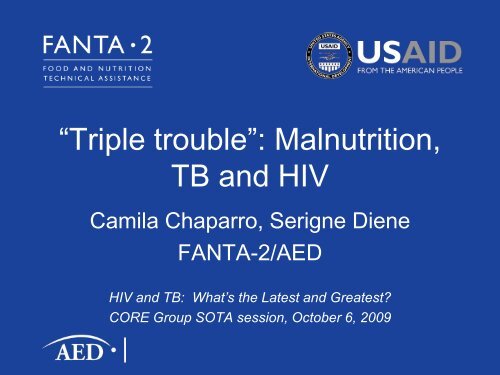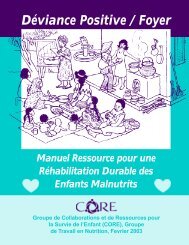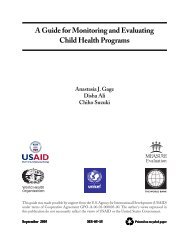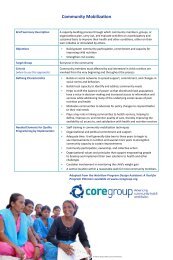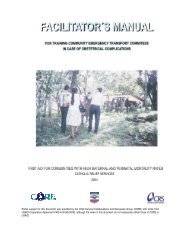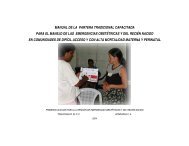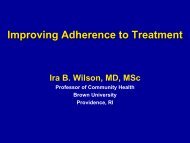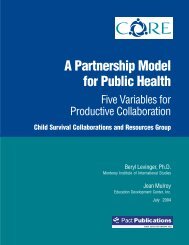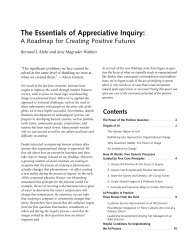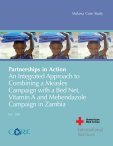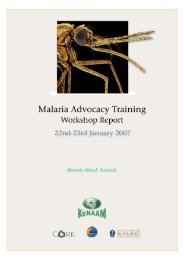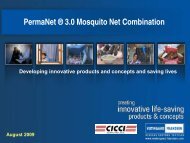“Triple troubleâ€Â: Malnutrition, TB and HIV - CORE Group
“Triple troubleâ€Â: Malnutrition, TB and HIV - CORE Group
“Triple troubleâ€Â: Malnutrition, TB and HIV - CORE Group
- No tags were found...
You also want an ePaper? Increase the reach of your titles
YUMPU automatically turns print PDFs into web optimized ePapers that Google loves.
Integration of Nutrition into National<strong>HIV</strong> ResponsesService Delivery• Nutrition assessment• Nutrition education <strong>and</strong> counseling• Specialized food products• Micronutrient supplementation• Water purification <strong>and</strong> hygiene• Food security support5
Package of Nutrition Services at Clinical<strong>HIV</strong> Care <strong>and</strong> Tx SitesMicronutrientsupplementation6
Food-by-Prescription ApproachCore components• Provision of set of nutrition services at clinicalfacilities as part of <strong>HIV</strong> care <strong>and</strong> Tx• Clearly defined entry <strong>and</strong> graduation criteria forspecialized food products• Prescriptions used for take-home foodpackages• Food packaged in daily consumption “doses”<strong>and</strong> aimed at improving individual nutrition <strong>and</strong>health status7
Lessons• Clinical facilities a good entry point forPL<strong>HIV</strong> nutrition services. But also need tointegrate into community services <strong>and</strong>establish two-way referral mechanismsbetween facility <strong>and</strong> community services.• Importance of integration into existingsystem – patient flow, information flow,etc. Ownership by medical stakeholders.8
Nutrition <strong>and</strong> <strong>TB</strong>Nutritionalsupport<strong>Malnutrition</strong>NutritionalsupportLatent <strong>TB</strong> Active <strong>TB</strong> <strong>Malnutrition</strong>9
<strong>Malnutrition</strong> as a risk factor for<strong>TB</strong>• General malnutrition reduces expressionof mycobactericidal substances maycompromise cell-mediated immunityleading to active <strong>TB</strong>– Intervention: Nutritional support to at-riskpopulations (where latent <strong>TB</strong> is common)?• Challenging to study relationship betweenmalnutrition <strong>and</strong> incidence of <strong>TB</strong>—limiteddata10
<strong>Malnutrition</strong> as a consequenceof <strong>TB</strong>• Active <strong>TB</strong> associated with:– Wasting: both fat <strong>and</strong> fat-free mass reduced• Multiple factors involved: poor appetite, increasedenergy expenditure (due to infection), alteredprotein metabolism– Micronutrient deficiencies (retinol, vitamins C<strong>and</strong> E, zinc, iron <strong>and</strong> selenium)– Anemia11
<strong>TB</strong> treatment <strong>and</strong> nutritionalstatus• <strong>TB</strong> treatment improves nutritional status, butlimited to gains in fat mass– Alterations in protein metabolism may continue duringtreatment– Typical diet may be inadequate to support lean massrepletion• R<strong>and</strong>omized controlled trial that provided an energy-protein supplement to<strong>TB</strong> patients receiving treatment showed gains in lean mass, <strong>and</strong> greater gripstrength (Paton et al, 2004)• Role for nutritional support during <strong>and</strong> after <strong>TB</strong>treatment, but limited data exist on mosteffective (<strong>and</strong> cost-effective) approach <strong>and</strong>needed duration of support12
Incorporating nutrition into <strong>TB</strong>programs (1)• Limited programmatic evidence of nutritionalsupport for <strong>TB</strong> prevents firm recommendations• Limited documentation on the role of nutritionalsupport in <strong>TB</strong> programs• Some recommendations* include:– Nutritional assessment for determination of nutritionalstatus <strong>and</strong> referrals– Nutritional counseling/education on symptommanagement <strong>and</strong> improved dietary intake during/after<strong>TB</strong> treatment*Source: Africa’s Health in 2010, Nutrition <strong>and</strong> Tuberculosis: A review of theliterature <strong>and</strong> considerations for <strong>TB</strong> control programs. 200813
Incorporating nutrition into <strong>TB</strong>programs (2)• Recommendations (cont’d)– Targeted micronutrient supplementation: vitamin B6,vitamin D– Food support for treatment of malnutrition in <strong>TB</strong> <strong>and</strong><strong>TB</strong>/<strong>HIV</strong> co-infected patients– Food support to increase treatment adherence14
WHO Consultation• “Scoping meeting for the development ofguidelines on nutritional/food support to prevent<strong>TB</strong> <strong>and</strong> improve health status among <strong>TB</strong>patients”– Nov. 2-4 2009– Convened by WHO Nutrition department, incollaboration with WHO Stop <strong>TB</strong>, UNAIDS <strong>and</strong> theWorld Food Programme– Invited participants: scientists, partner organizationswith experience in food support to <strong>TB</strong> patients,selected countries with <strong>TB</strong>/food support experience,WHO guideline review committee 15
WHO Consultation: Objectives• Review evidence base on <strong>TB</strong> <strong>and</strong> nutrition• Review potential for collaboration between<strong>TB</strong> <strong>and</strong> <strong>HIV</strong> programs <strong>and</strong> nutrition• Identify knowledge <strong>and</strong> research gaps <strong>and</strong>identify questions to be answered withsystematic reviews of existing research• Agree on a scope of guidelines on nutrition<strong>and</strong> <strong>TB</strong>, <strong>and</strong> establish a guideline group16
WHO Consultation: Review ofevidence• Undernutrition as a risk factor for <strong>TB</strong> infection<strong>and</strong> active <strong>TB</strong> disease• Effectiveness, cost <strong>and</strong> cost-effectiveness ofnutritional support for:– improvement of <strong>TB</strong> treatment outcomes– improvement of <strong>TB</strong> treatment adherence– nutritional rehabilitation of <strong>TB</strong> patients– reducing <strong>TB</strong> incidence• Special considerations for <strong>TB</strong> patients with <strong>HIV</strong>,MDR-<strong>TB</strong>, diabetes, <strong>and</strong> children17• Lessons learned from Nutrition-<strong>HIV</strong>
Discussion (1)• Drawing on your own experience…– What nutritional/food support are beingprovided to <strong>TB</strong> patients? What is the objectiveof the nutritional/food support (e.g., treatmentadherence, rehabilitation)?– What challenges <strong>and</strong> opportunities exist tointegrating nutrition support into <strong>TB</strong>programs? Or integrating nutrition, <strong>TB</strong> <strong>and</strong><strong>HIV</strong> programs?18
Discussion (2)– What key research questions related to <strong>TB</strong><strong>and</strong> nutrition are needed to improveprogramming?– What lessons from nutrition <strong>and</strong> <strong>HIV</strong>programs can be transferred to thedevelopment of nutrition support in <strong>TB</strong>programs?– What about using nutrition to prevent active<strong>TB</strong>? Is that feasible? A priority? What are theprogram platforms for doing this?19
Discussion (3)– What type of guidance, or for which specialgroups of <strong>TB</strong> patients (e.g., <strong>TB</strong>/<strong>HIV</strong> coinfected,children) is guidance most critical?20
This presentation is made possible by the generous support of theAmerican people through the support of the Office of Health, InfectiousDisease, <strong>and</strong> Nutrition, Bureau for Global Health, <strong>and</strong> the Sub-SaharanAfrica Bureau, United States Agency for International Development(USAID) , under terms of Cooperative Agreement No. GHN-A-00-08-00001-00, through the Food <strong>and</strong> Nutrition Technical Assistance IIProject (FANTA-2), managed by the Academy for EducationalDevelopment (AED). The contents are the responsibility of AED <strong>and</strong> donot necessarily reflect the views of USAID or the United StatesGovernment.Food <strong>and</strong> Nutrition Technical Assistance II Project (FANTA-2)Academy for Educational Development 1825 Connecticut Ave., NW Washington, DC 20009Tel: 202-884-8000 Fax: 202-884-8432 E-mail: fanta@aed.org Website: www.fanta-2.org21


